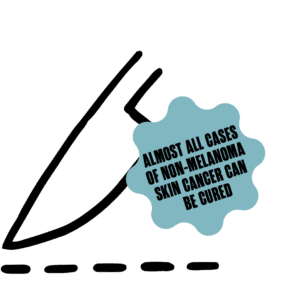
What is Skin Cancer?
Skin cancer is a type of cancer that typically starts on the top layer of skin called the epidermis. Basal cell carcinoma is the most common type of skin cancer, accounting for about 80% of all skin cancer diagnoses. Approximately 20% of skin cancers are squamous cell carcinomas. Other types of skin cancer include melanoma, merkel cell carcinoma, kaposi sarcoma, cutaneous lymphoma, skin adnexal tumors, and various types of sarcomas. While melanoma is rare and only accounts for about 1% of all skin cancers, it causes the majority of skin cancer deaths. Due to this, skin cancer is frequently discussed in two categories: Melanoma and Non-Melanoma skin cancer.
Who Does Skin Cancer Affect?
Anyone can get skin cancer. It is primarily diagnosed in people who have light skin, hair, and eyes, have many or abnormal moles, are older, or have had excessive ultraviolet (UV) exposure through the sun or tanning beds.
Basal Cell & Squamous Cell Carcinoma Facts
5.4m new diagnoses every year
2,000 people die every year

Melanoma Facts
In 2024,
100,640 new diagnoses
8,290 people will die
Melanoma has a
94% 5-year survival rate
White people are 20 times more likely to be diagnosed with melanoma than Black Americans. The lifetime risk of getting melanoma is about 2.6% for whites, 0.6% for Hispanics, and 0.1% for Blacks. However, Black people have the shortest survival after a melanoma diagnosis of any racial/ethnic group. The risk of melanoma increases as you get older. The average age of melanoma diagnosis is 66, but it is not uncommon among younger people and is one of the most common cancers in young adults (particularly people assigned female at birth). Gay and bisexual men are much more likely to develop skin cancer than heterosexual men.
*Note: All statistics are based on the U.S. population.
Skin Cancer Risk Factors
The risk factors of skin cancer are a combination of your genetics and lifestyle choices. Whether you have one or all of these risk factors, there is no guarantee you will develop skin cancer in your lifetime. Risk factors are important to understand so you can adjust your lifestyle-based risks and talk to your doctor about your overall risk.
Basal Cell and Squamous Cell Carcinoma Risk Factors
- Being exposed to ultraviolet (UV) light, primarily from the sun or tanning beds
- Having light-colored skin that freckles or burns easily, light-colored eyes, and/or naturally red or blonde hair
- Being older
- Being assigned male at birth
- Being exposed to large amounts of arsenic, coal tar, paraffin, and certain types of petroleum products
- Having radiation exposure
- Having a previous skin cancer diagnosis
- Undergoing psoriasis treatment (PUVA)
- Having xeroderma pigmentosum (XP)
- Having basal cell nevus syndrome
- Being immunocompromised
- Having HPV
- Smoking
Melanoma Risk Factors
- Being exposed to ultraviolet (UV) light, primarily from the sun or tanning beds
- Having many moles, atypical moles (dysplastic nevus syndrome), and/or having moles present at birth (congenital melanocytic nevi)
- Having light-colored skin that freckles or burns easily, light-colored eyes, and/or naturally red or blonde hair
- Having a personal or family history of melanoma or other skin cancers, particularly if it’s a first degree relative (parent, sibling, or child)
- Being immunocompromised
- Having xeroderma pigmentosum
Skin Cancer Warning Signs
Some skin cancers can be spotted early, but others can go undetected for many years. Here are some warning signs to keep an eye out for.
Basal Cell Carcinoma Warning Signs
For the most part, basal cell cancers develop on parts of the body that get exposed to the sun, such as the face, head, and neck, but they can occur anywhere on the body. Basal cell warning signs include:
- Flat, firm, pale, or yellow areas that look similar to a scar
- Raised reddish patches that could be itchy
- Small, pink or red, translucent, shiny, pearly bumps, which may have blue, brown, or black areas
- Pink growths with raised edges and a lower area in their center
- Open sores that don’t heal, or that heal and then come back
Squamous Cell Carcinoma Warning Signs
For the most part, squamous cell cancers develop on parts of the body that get exposed to the sun, such as the face, ears, neck, lips, and back of the hands. Occasionally, they form on the skin of the genital area, in scars, or in skin sores elsewhere on the body. Squamous cell warning signs include:
- Rough or scaly red patches, which could crust or bleed
- Raised growths or lumps that sometimes have a lower area in the center
- Open sores that don’t heal, or that heal and then come back
- Wart-like growths
Melanoma Warning Signs
Melanoma can develop anywhere on the body, but they are most likely to start on the chest or back in men and on the legs in women. Having a darker skin tone lowers your risk of melanoma at the common sites of the chest, back, or legs, but you are more likely to get melanoma on the palms of your hands, soles of your feet, or under your nails. For everyone, the melanoma warning signs include:
- A new spot on your skin or a spot that is changing in size, shape, or color
- A spot that looks different from all of the other spots on your skin
- Most melanomas are brown or black, but some can appear pink, tan, or even white
Learn more about cancer Early Detection.
Notice a warning sign? Talk to your doctor, not WebMD!
Preventing Skin Cancer
There is no surefire way to prevent skin cancer. However, you can make active decisions regarding your health that can potentially reduce your risk of skin cancer, including:
- Limit your exposure to ultraviolet (UV) rays. Seek out shade on sunny days, wear sunscreen everyday, wear sun protective clothing & sunglasses, stay away from tanning beds and sun lamps, and protect children from the sun. Learn more here.
- Avoid harmful chemicals such as arsenic.
- Don’t smoke.
- Avoid weakening your immune system (when possible).
Learn more about cancer Prevention.
Finding Skin Cancer Early
We say it all the time: Early detection saves lives. By finding skin cancer early, it is easier to treat and there are better treatment outcomes.
Here’s what you should be doing:
Skin Self-Exam
Everyone should do a skin self-exam once a month. Make a date with yourself to check out every square inch of your skin. We promise it’s sexy to put your health first. Learn more about what you’re looking for with the ABCDE’s of moles below.
Healthcare Professional Exam
If you are at high risk for skin cancer, you should have a doctor or dermatologist look at your skin closely once a year. They really know what to keep an eye out for and can make sure none of your moles are acting problematically.
The ABCDEs of Moles
The ABCDEs of Moles is a handy guide to get handsy with yourself. When you do your monthly skin self-exam, use these criteria to see if there’s anything to be worried about. It can be helpful to take pictures of your moles each month to track any changes over time. If you do find anything suspicious, be sure to tell your doctor or dermatologist about it.
A is for Asymmetry
When one half of the mole or birthmark doesn’t match the other half.
B is for Border
When the mole’s edges are irregular, ragged, notched, or blurred.
C is for Color
When the color of the mole isn’t the same all over.
D is for Diameter
When the spot is larger than 6 millimeters across (6 mm = about ¼ inch or the size of a pencil eraser).
E is for Evolving
When the mole is changing in size, shape, or color.
Not all skin cancers follow these rules. Make sure to tell your doctor about any new spots or growths that look different from the rest of your moles. Don’t forget to keep an eye out for:
- A sore that doesn’t heal
- A spot whose color is spreading into surrounding skin
- Redness or swelling beyond the border of a mole
- Itchiness, tenderness, or pain near a mole
- Changes to the surface of a mole, including scaliness, oozing, bleeding, lumpiness, or bumpiness
Tip: Use a mole tracker app to help keep an eye on your moles. We like Miiskin, MoleMapper, and UMSkinCheck.
Skin Cancer Treatment Options
Skin cancer treatment is very personalized and depends on several factors. Depending on the type of skin cancer you’ve been diagnosed with, you could be treated with a combination of surgery, radiation, immune response modifiers, cryotherapy, immunotherapy, targeted therapy drugs, or chemotherapy.
Treating Basal Cell and Squamous Cell Carcinomas
- Surgery – Surgery is a common treatment option for basal and squamous cell carcinomas. It could involve removing just the cancerous tumor, the tumor plus nearby normal skin to prevent future growth, or nearby lymph nodes to understand the cancer’s growth.
- Radiation Therapy – Radiation uses high-energy rays or particles to kill cancer cells. For basal and squamous cell carcinomas, radiation is used to treat large cancers, people who aren’t able to have surgery, or for tumors that are hard to treat surgically, such as on the eyelids, nose, or ears.
- Immune Response Modifiers – This treatment is used for basal cell carcinomas and works to boost your immune system to combat the cancerous cells. Immune response modifiers are usually used to treat very superficial tumors.
- Cryotherapy – Cryotherapy uses extreme cold to freeze and remove both basal and squamous cell cancers. It is usually used to treat large tumors in one treatment session or for people who cannot have surgery.
Treating Melanoma
- Surgery – Surgery is the main treatment for most melanomas and can usually cure early-stage melanomas. It could involve removing the cancerous tumor plus nearby normal skin, nearby lymph nodes, or removing the skin in very thin layers to understand how deep the cancer reaches in the skin.
- Immunotherapy – Immunotherapy uses medicine to help your immune system combat cancer more effectively.
- Targeted Therapy Drugs – These drugs target the aspects of melanoma cells that make them different from normal cells, and can be very effective at treating melanomas with certain gene changes.
- Chemotherapy – Chemo can be used after other treatments have been tried, but it’s rarely used as a first treatment for melanoma.
To learn more about what to expect at your first treatment appointment, visit our Life With Cancer page.
After Skin Cancer Treatment
After skin cancer treatment, there is always a chance of recurrence, where the skin cancer can come back, or a second cancer, where you are diagnosed later in life with an additional type of cancer. Making healthy lifestyle choices can help prevent a second cancer from developing.
Common Experiences of People with Skin Cancer
Cancer is unique and each person’s experience is completely valid. But some feelings can be universal. Here are a few common, but less discussed, experiences you might have with skin cancer.
Thinking That Skin Cancer is Your Fault Because You’ve Had Lots of UV Exposure
Spoiler Alert: cancer is never your fault. Just because you love hanging in the sun or used to go to the tanning salon a lot doesn’t mean you caused skin cancer. Lots of people have these same behaviors, but don’t get skin cancer. To a certain extent, cancer is up to chance. But, now that you know about it, it’s important to practice sun safety.
Feeling Embarrassed by Your New Scars
Since most skin cancers are treated with surgery, many people have scars afterwards. Depending on where your cancer was found, you could have new scars on your face, neck, chest, or arms – places that feel obvious and embarrassing. These feelings are normal, but try to remember all the things you love about yourself and that beauty comes from the inside. With time, you may even feel proud of your scars.
Source: American Cancer Society; Centers for Disease Control and Prevention; JAMA Dermatology










